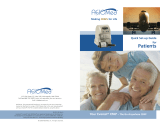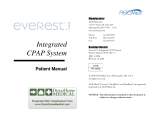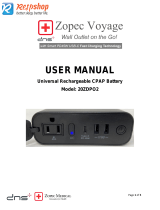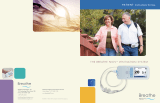Page is loading ...

VPAP
™
Adapt SV
User Guide
English
Front Cover - User.qxp 05/04/2006 4:31 PM Page 1

Global leaders in sleep and respiratory medicine www.myresmed.com
26869/2
06 04
VPAP Adapt SV
User
USA ENG
Bleed this panel onto spine (if applicable) but NOT onto Front Cover
Front Cover - User.qxp 05/04/2006 4:31 PM Page 2

VPAP
™
Adapt SV
User Guide
English
Reorder number: 26869/2 06 04

ResMed Ltd (Manufacturer) 1 Elizabeth MacArthur Drive Bella Vista NSW 2153 Australia
ResMed Corp (US Designated Agent) 14040 Danielson Street Poway CA 92064-6857 USA
ResMed (UK) Ltd (EU Authorized Representative) 65 Milton Park Abingdon Oxfordshire OX14 4RX UK
ResMed Offices Australia, Austria, Finland, France, Germany, Hong Kong, Japan, Malaysia, Netherlands,
New Zealand, Singapore, Spain, Sweden, Switzerland, UK, USA (see www.resmed.com for contact details).
Protected by patents: AU 691200, AU 697652, AU 702820, AU 709279, AU 724589, AU 730844, AU 731800, AU
736723, AU 734771, AU 750095, AU 750761, AU 756622, AU 761189, AU 2002306200, CA 2263126, EP 0661071, JP
3635097, JP 3737698, NZ 527088, US 4944310, US 5199424, US 5245995, US 5522382, US 5704345, US 6029665, US
6138675, US 6152129, US 6240921, US 6279569, US 6363933, US 6367474, US 6398739, US 6425395, US 6502572,
US 6532959, US 6591834, US 6659101, US 6945248, US 6951217. Other patents pending.
Protected by design registrations: AU 147283, AU 147335, AU 147336, AU 157903, AU 157904, AU 157905, CH
128.709, CH 128.710, CH 128.711, CN 200330123689.X, CN 200330123691.7, CN 200330123690.2, EP 000111190, DE
40202007, DE 40202008, DE 40201723, DE 40202020, ES 153514, ES 153515, ES 153516, ES 153518, FR 02 1407, GB
3001791, GB 3001819, GB 3001820, GB 3001821, JP 1164087, JP 1164265, JP 1164266, JP 1164267, SE 75598, SE
75599, SE 75600, SE 75715, US D467335, US D468011, US D476077, US D477868, US D493520, US D493884, US
D497203, US D498527. Other designs pending.
Activa, HumidAire, Mirage, ResControl, ResLink, ResScan, Smart Data, SmartStart, Ultra Mirage, Vista, VPAP and VPAP
Adapt SV are trademarks of ResMed Ltd. Activa, Humidaire, Mirage, SmartStart, Vista and VPAP are registered in U.S.
Patent and Trademark Office. SmartMedia is a trademark of Toshiba.
© 2006 ResMed Ltd.

iContents
Contents
Introduction . . . . . . . . . . . . . . . . . . . . . . . . . . . . . . . . . . . . . . . . . . . . . . . 1
VPAP™ Adapt SV 1
User/owner responsibility 1
Definitions 1
Medical Information 1
Intended Use 1
Contraindications 1
Warnings 2
Cautions 2
Quick Setup Guide . . . . . . . . . . . . . . . . . . . . . . . . . . . . . . . . . . . . . . . . . 5
VPAP Adapt SV System . . . . . . . . . . . . . . . . . . . . . . . . . . . . . . . . . . . . 7
VPAP Adapt SV Components 7
Masks 8
Assembling the VPAP Adapt SV System 9
Humidifiers 11
Connecting a Humidifier 11
HumidAire 2i™ 12
HumidAire™ 13
ResLink™ 15
Anti-bacterial Filter 15
Using DC Power to Run the VPAP Adapt SV 16
Supplemental Oxygen 16
Using the VPAP Adapt SV . . . . . . . . . . . . . . . . . . . . . . . . . . . . . . . . . 17
Starting Treatment 17
Stopping Treatment 17
Standby Mode 17
Control Panel Functions 18
Adjusting Settings 19
Menus 21
Settings Menu 22
Results Menu 23
Options Menu 24
Servicing Menu 25
Treatment Screens 25
Alarms . . . . . . . . . . . . . . . . . . . . . . . . . . . . . . . . . . . . . . . . . . . . . . . . . . . 27
Low Mask Pressure Alarm 27
Power Fail Alarm 28
High Pressure Alarm 28
High Leak Alarm 28
Insufficient Pressure Support Alarm 29
Flow Blocked Alarm 29

ii
Cleaning and Maintenance . . . . . . . . . . . . . . . . . . . . . . . . . . . . . . . . 31
Daily 31
Weekly 31
Periodically 32
Air Filter 33
Hypoallergenic Air Filter 33
Servicing 33
Troubleshooting . . . . . . . . . . . . . . . . . . . . . . . . . . . . . . . . . . . . . . . . . . 35
Glossary . . . . . . . . . . . . . . . . . . . . . . . . . . . . . . . . . . . . . . . . . . . . . . . . . 37
Technical Specifications . . . . . . . . . . . . . . . . . . . . . . . . . . . . . . . . . . . 39
Limited Warranty . . . . . . . . . . . . . . . . . . . . . . . . . . . . . . . . . . . . . . . . . 47
Index . . . . . . . . . . . . . . . . . . . . . . . . . . . . . . . . . . . . . . . . . . . . . . . . . . . . . 49

1Introduction
Introduction
VPAP™ Adapt SV
The VPAP™ Adapt SV flow generator has been designed to be reliable,
comfortable and easy to use. You can observe your treatment and make
adjustments to settings using a keypad and LCD screen.
!
CAUTION
USA federal law restricts this device to sale by or on the order of a
physician.
User/Owner Responsibility
The user or owner of this system shall have sole responsibility and liability for any
injury to persons or damage to property resulting from:
• operation which is not in accordance with the operating instructions supplied
• maintenance or modifications carried out unless in accordance with
authorized instructions and by authorized persons.
Please read this manual carefully before use.
Definitions
!
WARNING
Heading alerts you to possible injury.
!
CAUTION
Explains special measures for the safe and effective use of the device.
Medical Information
Intended Use
The VPAP Adapt SV system is intended to provide non-invasive ventilatory
support to treat adult patients with obstructive sleep apnea (OSA) and respiratory
insufficiency caused by central and/or mixed apneas and periodic breathing. This
device is intended for use in the hospital or home.
Contraindications
The VPAP Adapt SV is not a life support ventilator and may stop operating with
power failure or in the unlikely event of certain fault conditions.
Before using the VPAP Adapt SV tell your doctor if you have any of the following
conditions:
• hypotension or significant intravascular volume depletion
• acute sinusitis or otitis media
• epistaxis (severe nose bleeds) causing a risk of pulmonary aspiration
• conditions predisposing to a risk of vomiting into mask

2
• impaired ability to clear secretions
• pneumothorax or pneumomediastinum
• recent cranial trauma or surgery
• chronic hypoventilation.
Below are general warnings and cautions. Further specific warnings,
cautions and notes appear next to the relevant instructions in the manual.
!
Warnings
• The VPAP Adapt SV is NOT a life support ventilator.
• The entire manual should be read before using the VPAP Adapt SV.
• Advice contained in this manual should not supersede instructions given by
the prescribing physician.
• The VPAP Adapt SV should be used with masks and accessories
recommended by ResMed or the prescribing physician. Use of incorrect
masks and accessories may adversely affect the function of the
VPAP Adapt SV.
• The VPAP Adapt SV is designed for use with masks that allow exhaled gases
to be flushed out through vent holes. Exhaled gases will be rebreathed if the
mask is worn with the machine turned off, or the vent holes are occluded. If
this occurs over prolonged periods, suffocation may occur.
• In the event of power failure or machine malfunction, remove the mask.
• The air flow for breathing produced by this device can be as much as 11
o
F
(6
o
C ) higher than the temperature of the room. Caution should be exercised
if the room temperature is warmer than 90
o
F (32
o
C).
• The VPAP Adapt SV can be set to deliver pressures up to 20 cm H
2
O. In the
unlikely event of certain fault conditions, pressures of up to 40 cm H
2
O for
less than one second are possible.
• The VPAP Adapt SV is not suitable for use in the vicinity of flammable
anesthetics.
• If oxygen is used with the VPAP Adapt SV, the oxygen flow should be
stopped when the device is not operating. If oxygen flow continues when
the device is not operating, oxygen may accumulate within the device and
create a risk of fire.
• Do not use the VPAP Adapt SV if there are obvious external defects or
unexplained changes in performance.
• Do not open the VPAP Adapt SV case. There are no user serviceable parts
inside. Repairs and internal servicing should only be performed by an
authorized service agent.
!
Cautions
You should report unusual chest pain, severe headache or increased
breathlessness to your physician. An acute upper respiratory tract infection may
require temporary discontinuation of treatment.

3Introduction
The following side effects may arise during a course of therapy with the
VPAP Adapt SV:
• drying of the nose, mouth, or throat
• bloating
• ear or sinus discomfort
• eye irritation
• skin rashes
• chest discomfort.

4

5Quick Setup Guide
Quick Setup Guide
1 Attach the air tubing and pressure sensor tube to the VPAP Adapt SV and mask
(page 9).
2
Attach a humidifier if required (page 11).
3
Switch on the VPAP Adapt SV. Make sure the mask is unblocked.
4
Select the mask setting (page 22).
5
Perform the Air Circuit Learn function (page 22) at first-time use, or if you are
adding or removing a component of the system (eg, a humidifier or anti-bacterial
filter).
6
Fit the mask and commence breathing into it. The SmartStart™ function should
trigger treatment to commence within the first couple of breaths. If not, press
the Start/Stop key once to commence treatment (page 17).
Note: You can observe treatment progress (eg, mask leak) via the Treatment
screens (page 25).
7
Remove your mask to stop treatment. If SmartStop is enabled, treatment will
stop automatically. If the SmartStop function has been disabled, press the
Start/Stop key once.

6

7VPAP Adapt SV System
VPAP Adapt SV System
VPAP Adapt SV Components
The VPAP Adapt SV flow generator is supplied with air tubing and a power cord.
Masks are supplied separately, as you and your clinician have to decide which
mask is best for you. Masks that can be used with VPAP Adapt SV are listed on
page 8.
Some people experience dryness of the nose, mouth and throat while using the
VPAP Adapt SV system, especially during winter. Others may experience
sneezing and/or a runny or blocked nose during the first few weeks of VPAP
treatment. In many cases, these symptoms of nasal irritation can be resolved
with a humidifier. See page 11 to connect a humidifier to the VPAP Adapt SV.
Figure 1: VPAP Adapt SV flow generator
The control panel allows you to adjust settings on the flow generator, and the
LCD screen displays information about your treatment. See “Control Panel
Functions” on page 18.
Figure 2: Rear of VPAP Adapt SV
See page 15 to connect a ResLink™. See page 33 to replace the air filter.
Air tubing connector
Pressure sensor
Control panel
LCD screen
Removable
front cover
tube connector
Carry handle
Air filter
Power cord
ResLink attachment point

8
Figure 3: Air tubing fully assembled
All necessary air tubing components are packed with the VPAP Adapt SV:
• a 6’6" (2 m) length of air tubing
• a pressure sensor tube (to measure pressure at the mask) with Luer
connectors
• tube clips (to hold the pressure sensor tube onto the air tubing)
• a proximal cuff (a special connector that attaches the pressure sensor tube
into the main air tubing so that you only need to make one attachment to the
mask).
The air tubing is supplied with the Proximal cuff connected. Attach the tube clips
evenly along the air tubing. Press the pressure sensor tube into the tube clips,
and screw the Luer connectors together at the Proximal cuff. Make sure the
pressure sensor tube is not kinked, obstructed or twisted.
Note: ResMed recommends the following tubing products for use with the
VPAP Adapt SV: replacement air hose (only) PN14968; replacement air delivery
system (hose, sensor line, clips, proximal cuff) PN26923.
Masks
The following mask systems (supplied separately) are recommended for use
with the VPAP Adapt SV system. Please refer to the table on page 22 to set up
your mask correctly for use with the VPAP Adapt SV.
Your clinician can explain the features of the masks available and will discuss the
mask that best suits your needs.
Proximal cuff
Pressure sensor tube
Tube clip
Connect this end
to the mask
Connect this end
to the flow generator
Luer connector
Air tubing
Mirage™ Full Face
Mask Series 2
Ultra Mirage™
Mirage Vista™
Mirage Activa™
Ultra Mirage™
Full Face Mask

9VPAP Adapt SV System
Assembling the VPAP Adapt SV System
Complete the following steps to assemble the VPAP Adapt SV system. Make
sure the area around the unit is clean (dust free) and clear of bedding, clothes and
any other potential blockages.
To add a humidifier see page 11.
!
WARNING
Use only the air tubing system supplied with the VPAP Adapt SV system.
1
Connect the power cord
There are two sockets at the rear of the flow generator—the top one for an AC
(standard mains electricity) and the lower one for a DC power cord (see “Using
DC Power to Run the VPAP Adapt SV” on page 16). ResMed recommends using
the AC power cord supplied with the unit.
The customized ResMed power cord can be held in place with the locking clips.
To insert the locking clip, pinch the free ends together and fit the pins into the
holes on both sides of the socket. Insert the power cord into the socket. Push
the locking clip down so that the groove holds the power cord in place. Plug one
end of the power cord into the power socket at the rear of the unit, and the other
end into a power outlet.
Plug the free end of the power cord into a power outlet.
!
CAUTIONS
• Do not connect both AC and DC power cords to the VPAP Adapt SV at
the same time.
• Be careful not to place the device where it can be bumped or where
someone is likely to trip over the power cord.
!
WARNING
Make sure the power cord and plug are in good condition and the
equipment is not damaged.
Power switch
AC locking clip
AC power cord

10
2
Connect air tubing
Connect the air tube firmly onto the air outlet at the front of the unit.
Figure 4: Front view of VPAP Adapt SV
To attach the pressure sensor tube to the unit, screw the Luer connector onto
the socket on the side of the unit.
Figure 5: Twisting the Luer lock connectors together
!
WARNING
Use care when handling the air tubing. Be particularly careful when
attaching the Luer connector to the VPAP Adapt SV. If you kink or
excessively twist the sensor tube it may affect the protection offered by the
mask pressure alarm system.
3
Attach the mask to the air tubing.
The mask system should already be assembled. If not, please refer to the user
instructions supplied with the mask.
Connect the mask system to the free end of the air tubing.
Figure 6: Assembling the VPAP Adapt SV system
Air tubing connector
Pressure sensor tube
connector
Proximal cuff

11VPAP Adapt SV System
Humidifiers
A humidifier may be required if you are experiencing dryness of the nose, throat,
or mouth. The following ResMed humidifiers are compatible with the
VPAP Adapt SV:
Figure 7: Humidifiers compatible with the VPAP Adapt SV
When using a humidifier, stop the
VPAP Adapt SV
by using the Start/Stop key or
by removing the mask to trigger the
SmartStop
function. Do not switch the
VPAP Adapt SV
off at the power switch or the power source while it is running, as
this could result in condensation in the motor.
Please refer to the relevant humidifier user manual for detailed instructions and
warnings.
!
CAUTIONS
• Be very careful not to allow water to enter the VPAP Adapt SV as this
could affect therapy and/or damage the device.
• Do not tip the humidifier while it is connected to the VPAP Adapt SV. If
water enters the VPAP Adapt SV device, turn off the main power switch
at the back of the unit and unplug it from the power outlet. Return the
unit to your equipment supplier for checking.
Connecting a Humidifier
Note: After connecting or removing a humidifier, always perform the Air Circuit
Learn function (see page 22).
!
WARNING
When using a humidifier, position it so that it is lower than your head will
be during sleep, and at the same level or lower than the VPAP Adapt SV.
HumidAire 2i™
heated humidifier
Medium air tubing
21" (52 cm)
Humidifier accessory (HumidAire only)
HumidAire™
heated humidifier

12
HumidAire 2i™
The HumidAire 2i provides heated humidification for the VPAP Adapt SV.
To attach the HumidAire 2i, remove the VPAP Adapt SV front cover and attach
the humidifier docking station and water chamber. No other accessories are
required for use. Please refer to the HumidAire 2i User’s Manual for details.
Once you have performed the Air Circuit Learn function the VPAP Adapt SV is
ready for use. See “Starting Treatment” on page 17.
Figure 8: HumidAire 2i attached to the VPAP Adapt SV
Figure 9: HumidAire 2i attached to VPAP Adapt SV and mask
!
WARNINGS
• Make sure that the water chamber is empty and thoroughly dried before
transporting the HumidAire 2i.
• When using the carry bag, always separate the VPAP Adapt SV unit and
the Humidaire 2i before placing in their respective compartments.
VPAP Adapt SV
HumidAire 2i
water chamber
docking station
HumidAire 2i

13VPAP Adapt SV System
HumidAire™
You will need a medium size 21" (52 cm) air tube to connect the VPAP Adapt SV
unit to the HumidAire™ (see Figure 7).
1 Make sure both the HumidAire and the VPAP Adapt SV are turned off.
Fill the HumidAire with water as described in the humidifier manual. Place the
filled water chamber inside the HumidAire.
2
Gently detach enough of the tube clips to release the end of the pressure sensor
tube from the VPAP Adapt SV air tubing.
Connect the
VPAP Adapt SV
air tubing to the left connector port on the humidifier,
and the medium 21" (52 cm) air tubing to the right connector port. Close the
HumidAire
lid.
3
Place the VPAP Adapt SV on top of the HumidAire. Never place the
VPAP Adapt SV unit underneath the humidifier. (This is to avoid water spilling into
the unit.)
4
Connect the free end of the medium air tubing to the VPAP Adapt SV.
Connect the pressure sensor tube by twisting the Luer lock onto the
VPAP Adapt SV (see page 10).
HumidAire
Medium air tubing
VPAP Adapt SV air tubing
Pressure sensor tube

14
5
Connect the mask system to the free end of the long air tubing. The final
assembly should look like this:
6
Switch on the HumidAire and the VPAP Adapt SV.
!
WARNING
Make sure that the power cords and plugs are in good condition and the
equipment is not damaged.
7
Perform the Air Circuit Learn function (see page 22).
For information about filling and maintaining your humidifier, refer to the
HumidAire User’s Manual.
The VPAP Adapt SV is now ready for use with the HumidAire. See “Starting
Treatment” on page 17.
!
CAUTIONS
• Set up the HumidAire and the VPAP Adapt SV unit so that the tubing to
the mask runs higher than the machines. This will prevent condensation
build-up.
• If condensation appears in the mask, turn the humidifier settings down.
/



